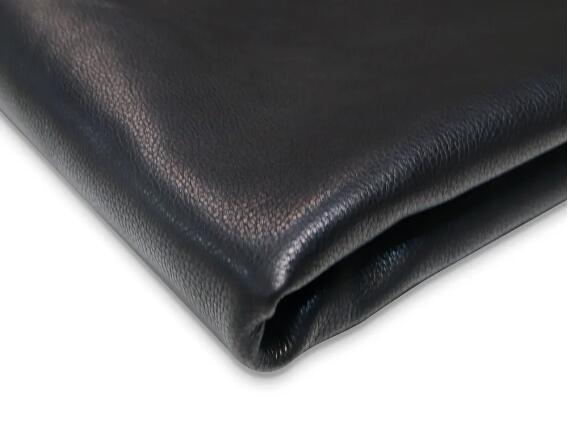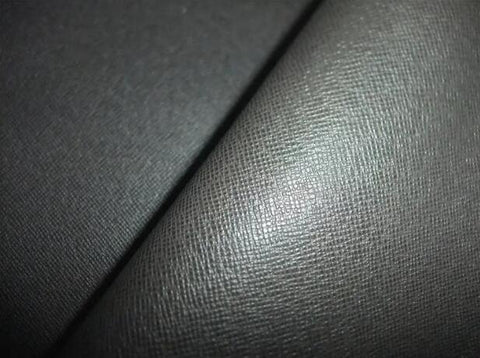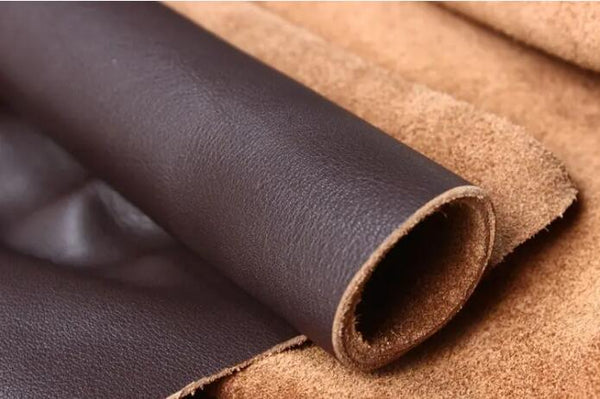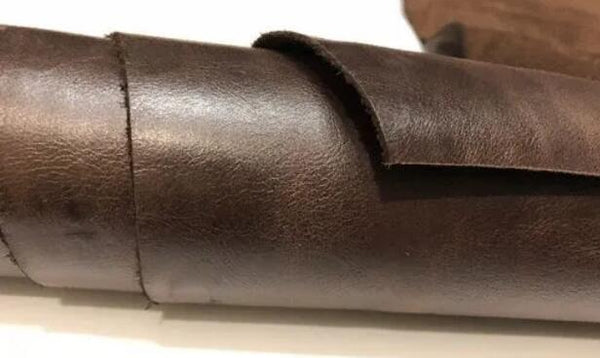Your cart is currently empty
What Is Full Grain Leather?
If you ask, what is full-grain leather? The area of a hide immediately below the hair is known as the full grain and is the toughest. Therefore, when the coat is processed into leather, the resulting items are exceptionally sturdy and long-lasting. Full-grain leather retains as much of its natural sheen without being polished or sanded. Tightly interwoven threads give full-grain Leather its strength and longevity. Full-grain leather can be sourced from a wide variety of animals, from the more commonplace cow or pig to the more outlandish alligator.
Full grain leather meaning is the Leather's natural fibers make it more robust and long-lasting. A patina will form on it over time as well. The patina of age is a transformation in hue. In the world of historic cars, you can hear this term bandied about when referring to the practice of applying a clear coat over the mild corrosion and exposed steel of an antique car.

Precisely what does "real leather" entail?
Genuine Leather refers to any substance that could be mistaken for leather. Many buyers are confused by this label since it appears to be of high quality but provide little information about the product's composition. Unlike full grain leather, genuine Leather doesn't necessarily have the top grain because it might come from any layer of the hide. The term "new hide" can also refer to fragments of Leather that have been ground up (similar to ground beef) with adhesives to create genuine Leather.
Additionally, the material is amenable to a wide variety of processing methods. It might be smoothed out or fixed, so it's completely free of defects. Due to the weakening effects of these procedures, genuine leather wears out far more quickly than full grain leather. Since the term "genuine leather" refers to a somewhat broad category of leather, the quality of any two given goods may vary significantly. Though theoretically the same as genuine leather, high-quality materials like full grain leather are rarely advertised due to the term's pejorative connotations.
Is full-grain leather genuine leather?
It's also possible to be misled by the phrase "genuine" Leather, which, in theory, could apply to anything made of leather. In practice, however, genuine leather is typically used for goods that will be handled frequently or by less careful people. As a result, when people hear the word "genuine," they automatically think of the finest Leather possible. The highest quality leather is full grain leather; therefore, search for that mark when purchasing leather goods.
Is it better to use full grain leather?
You can't beat the quality of full grain leather. Since most authentic products have been processed extensively and come from different portions of the hide, they are much lower than whole grain. Even though genuine leather may be less expensive than full grain leather, the latter has superior quality in both beauty and longevity.

What is the difference between grain leather and full-grain Leather?
-
Outward Appearance
Pores, scars, and other flaws may still be evident on full grain leather since the top layer of the Leather has not been treated to remove its natural imperfections. That makes the Leather look genuine and gorgeously unique, although some people may prefer a more uniform appearance. However, top-grain Leather has had that outer layer sanded off and treated so that what's underneath is smooth and free of imperfections. Some companies will use aniline dyeing on top-grain Leather to make it appear more uneven as if it were made from full grain leather.
-
Durability
Even though top-grain Leather is generally treated to prevent stains, full grain leather is thicker and more durable, but it can stain more quickly and show colors more visibly. The Leather in both cases is authentic and of the highest quality. Top-grain and full grain leather, if cared for properly, can last generations.
-
Price
Full grain leather will always cost more than top-grain Leather because of its better quality and thickness and because it is often considered more challenging to work with.
-
Care
Cleaning and conditioning top-grain and full-grain leather regularly will keep the Leather supple and protected from dirt and stains. As a rule of thumb, once every six months, clean the Leather and condition it, making sure to let the Leather dry entirely after each process. Keep your Leather out of direct sunshine and other drying heat or air sources.
You should consider your budget and the desired aesthetic when deciding whether top-grain or full-grain Leather is more appropriate for your project. Top-grain Leather, on the other hand, is smoother and thinner than full grain leather, and it lacks the flexibility and suppleness that come from using an animal hide.
Does full grain leather peel?
The Leather of a high grade will not peel. When cared for properly, a high-quality piece of Leather can survive for decades while retaining its elegance. All leathers are not the same, however.
Some leathers peel or break after only a few uses, while others can be passed down through the generations. Leather can dry up and crack over time, which is a bummer because it means your favorite shoes, purses, coats, or couch may eventually need replacing—a tragic event for a leather lover.
Since it is created from animal hide, genuine leather needs to be cared for and conditioned to retain its flexibility and durability. However, low-quality leather sometimes dries out, cracks, and even peels. High-quality leather, on the other hand, maintains its appearance and rarely peels.
To what end does Leather peel?
1. Deficiency in Leather Quality:
Leathers may peel for various reasons, but one of the most common is low-quality construction. Many different items might be named in conjunction with Leather that is of poor quality;
2. Improper Care and Maintenance:
Inadequate upkeep and care are another typical cause of leather peeling. Leather, especially natural Leather, is rather sturdy, but it needs regular care to keep it from drying out, cracking, and peeling. This is significant regardless of the type of Leather used. Without routine maintenance, Leather dries up, becomes brittle, and eventually peels.
3. Exposure To Moisture:
Wet conditions can also cause Leather to peel. If your leather item becomes wet, dry it off quickly and condition it as soon as possible. Natural oils used in leather production must be kept intact within the Leather's pores. A lack of timely conditioning causes Leather to dry up and peel when exposed to regular wetness because the Leather's natural oils have been washed away.

4. UV Radiation:
Constant exposure to the sun can also cause peeling in Leather. Sunlight depletes Leather's natural oils, leading to drying and cracking. Therefore, UV protection is essential for conditioning and protecting leather items that spend a lot of time in the sunlight.
5. Age:
As leather ages, it can also develop a peeling effect. Without adequate maintenance and care, Leather's natural oils will dry up and crack over time, causing the material to look older and worn.
Preventing Leather from Peeling and How to Care for It:
Leather that doesn't peel requires a different maintenance routine than regular Leather. Some advice is as follows:
- Water or any other form of moisture should be kept away from the Leather.
- Avoid using any harsh cleaners or chemicals on the Leather.
- Avoid harsh rubbing or scratching to preserve the Leather's quality.
- Maintain the Leather with frequent conditioning.
- If your Leather spends a lot of time in the sunlight, you should treat it with a UV protector.
- You should keep the Leather in a dry, cold place.
A professional's advice should be sought if you are unsure how to care for your leather goods. They may advise you on how to keep the Leather in good condition to prevent it from peeling.
Why does Leather crack when you rub it?
We don't always know what causes the Leather on our bags and belts to start peeling. Quite a few factors contribute to its occurrence. It could be the Leather's quality or the cleaning agents we use. In the parts that follow, I provide elaborate justifications for each point.
Chemicals and Products for Cleaning:
Every time we notice a fissure in our "leather," we automatically attribute it to wear and tear. The sealer applied to the Leather's surface is often the culprit when it cracks rather than the Leather itself. The leather cleaning products we use, such as those with alcohol and solvents, could be to blame. Rubbing alcohol is used to clean our leather bags as an illustration.

Bonded Leather
It turns out that not all of the leather goods we own are genuine. Some are true of subpar construction. Bonded Leather is a typical example of low-quality Leather that peels readily. Bonded Leather is a hybrid material that combines natural and synthetic Leather. The remaining pieces from production are ground into a pulp, glued together, and then covered with polyurethane (PU).
Leather substitute
As a less expensive substitute for genuine Leather, synthetic Leather is frequently utilized for various products. Even though it costs less than other types of Leather, it easily peels and is therefore not a good option. It's a synthetic material, like PU or PVC. Its low quality makes it break much as bonded Leather would.
High-quality Leather is much less likely to suffer from flaws like cracking or peeling. In fact, unlike low-quality Leather, it improves with age. To get our money's worth out of Leather, it is in our best interest to learn as much as possible about the type of Leather and the standards under which it was produced.
Steel Horse Leather only uses premium full grain leather from the most reputable sources in the industry. To ensure that the Leather we use in our goods is long-lasting and sturdy, we treat it using unique processes and high-quality waxes.
Products Full-grain Leather Is Commonly Used For
Furniture, dress shoes, work boots, dress belts, briefcases, duffle bags, wallets, and many other leather goods are just some of the many uses for full grain leather. Because of its resilience and sturdiness, this Leather is well suited for products that are subjected to rough and frequent use.
Advantages of Full-grain Leather
Full-grain Leather's inherent worth comes from the animal hide's intrinsic beauty, which highlights every scar and flaw. Because of its durability and strength, full grain leather is perfect for high-end furnishings and accessories that will last for years. As it ages, it will acquire a deep patina that will make it more beautiful and desirable to collectors.
Disadvantages of Full-grain Leather
It will cost you a little bit more to get your hands on some whole-grain leather. Because it is more challenging to deal with, it is more costly to make. Since full grain leather is so stiff, it can't be used for anything that needs a flexible material. In comparison to other leathers, it does not resist stains very well. Animal hide is inconsistent due to its inherent flaws and surface distortions.
Caring for Full-Grain Leather
To ensure that your full grain leather product lasts for many years without breaking down, it is essential to maintain it in accordance with the manufacturer's guidelines. When caring for full-grain Leather, remember that scuff marks can be easily erased from oiled Leather by rubbing the affected area with a damp finger. Dampen a cloth and wipe down the affected area for extra thorough cleaning.
If your leather item becomes wet, you should never dry it with heat because doing so might cause cracking. Dry it at room temperature instead. After the Leather has dried, using conditioner or similar leather protector will help maintain its cleanliness and prevent overdying.
Comparison
While top-grain and full grain leather begin with animal hides, the former undergoes additional processing—specifically, sanding and buffing—to remove the top layer and its inherent flaws. This produces a smoother surface, but the Leather isn't as sturdy as full-grain. It's more uniform in appearance than full-grain, but it's not as high-quality or sturdy. After the outer layer of the hide has been removed, the hide is often stamped with designs meant to resemble alligator or ostrich skin. Leather with a grain altered in this way is called corrected-grain Leather. Top-grain Leather, like full-grain, is typically reserved for high-end products.
Conclusion
Full-grain Leather is the highest quality leather you can get, but it is also the most expensive. It serves its purpose, looks nice, and offers excellent value because of its longevity. This is the kind of Leather to choose from if you want an item that will last a lifetime and gain character with time. Even though Leather is a gorgeous and abundant material, not all are created equal. When maintaining your leather goods, it's important to follow the manufacturer's guidelines. Natural Leather is your best bet if you're looking for a peel-resistant material. It's long-lasting and sturdy and may serve you well for many years if you treat it right.
FAQ:
How long does full-grain Leather last compare to lower-quality Leather?
Compared to other fabrics, full grain leather has five times the higher lifespan. When properly cared for, genuine grain leather can last for decades.
Is there a distinction between full-grain Leather and full-grain Leather upper?
The "uppers" of a boot or shoe, as opposed to the "soles," are what is meant by the phrase "full grain leather uppers." This label only refers to a distinct shoe component and should not be confused with full-grain Leather.
When it comes to full-grain Leather, how thick is it?
Full-grain Leather can be deceptive because it can mean many different things from maker to manufacturer. If it were cut, the thickness would be other than if it hadn't been.
Do you think rectified Leather is the same as full grain leather?
No. There is no sanding or buffing done to full-grain Leather. If something is labeled as "fixed," all surface flaws have been polished or sanded out. The term "corrected leather" refers to a leather product with a defect that the producer has fixed so that the product seems consistent throughout.
Consider your skin; just as you can have a scar from an old injury or a mark from a particularly nasty bug bite, animals are subject to the same damage. To achieve a uniform look, makers will detect a scar on the hide, whether from an injury or a bug bite, and then smooth it over.
Is there a difference between whole grain and bonded Leather?
On the other hand, Bonded Leather is the "chicken nugget" of the leather industry because it is made from recycled leather scraps. The exterior of bonded Leather is typically embossed with a print designed to mimic the look of the genuine leather grain, just as that found in full grain leather. Bonded Leather has a lower initial quality and becomes increasingly harder to mend as time passes.
What makes full-grain Leather unique compared to top-grain or split Leather?
The two layers that result from a rawhide being cut in half are the 1) top grain layer and 2) the split layer. Top grain leather is typically used for nubuck leather, while split leather is generally used for suede.
Do you mean full Leather when you say genuine Leather?
Equally deceptive is the word "genuine" Leather, which in theory could apply to anything made of Leather. In practice, however, split grain leather is typically used for goods that will be handled frequently or by less careful people. In this way, the word "genuine" has come to be associated with only the finest Leather. The highest quality leather is whole grain; therefore, search for that mark when purchasing leather goods.
Shop our collection of:
Real Leather Backpacks | Leather Bags For Men | Leather Bags For Women | Custom Leather Journals | Leatherbound Sketchbooks | Leather Traveler's Notebook
Related Blog Posts:




